If you missed the first part of our typical shopping timeline, you can read it here. Also, a blogging friend of mine just published an incredible post on a market in her area of the country, and it’s definitely worth the read – and a glance at her beautiful pictures!
But for now, here’s the rest of our shopping day….
10:45 am – To the market. In many villages, there is only one market day. For example, in a nearby village where we occasionally travel to stay at a retreat center, Thursday is market day. I am always amazed at this because most Nigerians don’t have refrigeration, and yet they manage to get their produce to last longer than I can WITH refrigeration. Because Jos is a larger city, however, the market runs every day – though you will often find that Friday afternoons during mosque there will be quite a few empty stalls, and on Sundays the market is virtually – though not completely – empty.
It’s hard to describe the myriad of sights, sounds and smells (Oh, the smells, especially near the meat section!) in the market, as well as the chaos that can sometimes prevail. Perhaps the closest description would be something like a combination of a really large community yard sale (with its different sellers and tables and sections set up), combined with a fair or carnival (with people shouting at you from all directions to come play their games) – minus the yummy elephant ears, fried Twinkies and questionable rides – a farmers’ market (with its colorful assortment of fruits and vegetables) and a Black Friday sale (I’ll let you draw your own conclusions on that one).
The main market in Jos doesn’t just sell fruits and vegetables. You can find meat – both alive and dead, familiar parts and unfamiliar parts – and rows and rows of beautiful fabrics in vibrant African colors. You can buy eggs, linoleum, curtain fabric (and find a tailor to sew them, too), “plastics” (which Nigerians seem to love – entire shops sell just plastic things like buckets, baskets, trays, plates, cups and shelves), brooms and diapers. Bright red palm oil poured into old water bottles is sold alongside piles of dried fish, a common seasoning used in soups. There are heaps of used clothing, usually from foreign countries, and men selling the clothes will yell out the clothing they have as they hold up a selection to entice those passing by. If you’re willing to spend time looking, you’d be surprised at what you can find.
There are rows and rows of shops in the market, but many people sell from wooden tables set up in the crowded aisles of the market or tilted wooden stalls with tin roofs. Others sell from barrels – bushels of flour and grains, for example, and even popcorn kernels, as they sit under an umbrella waiting for customers – or trays, carts or even mats on the ground, their merchandise spread out before them. Some wander through the market selling from wheelbarrows, yelling “Hanya, hanya!” (literally “road” but essentially “give way”) as they push through the crowds, while others sell from baskets, buckets or trays balanced on their heads as they wander through the market: men with garlic and meringue powder or plantains; women with buckets of dried crayfish, boiled eggs or masa; young girls with tofu; boys with long stalks of sugar cane. Young boys wander around the market selling bags, shoving them in your face and saying, “Buy ‘leda'” (That’s what it sounds like they are saying, anyway, but it’s actually “leather,” which I’m assuming comes from a time when shopping bags really were made from leather, though that’s just a guess). The bags are stronger than the bags you get when you buy fruits and vegetables – as I learned the hard way when a large bag of potatoes I had purchased split open and went tumbling all over the market. The boy whom I had just told no, I’m fine, I don’t need a bag, knelt down to help pick them up, smiling, “Buy ‘leda.'” I bought “leda.”
…And if you’re feeling homesick, you might even see bags from familiar stores back home, as the time I saw a boy carrying stacks of bags with Super Target emblazoned across them.
You needn’t fend for yourself with your purchases, either. For a small fee, the same boys who sell bags are also willing to help carry your purchases, escorting you to your car (even if it is parked several blocks away) or to the main road to catch a taxi. Many times I’ve struggled with carrying my bags, only to have a young boy effortlessly throw some of my purchases on his head, leaving me thinking that I have GOT to learn how to do that! And who needs shopping carts when you can hire a young man and his wheelbarrow to cart larger buys?
Occasionally the government will decide that they want to clean up the market, so they will do a sweep through and clear out those who don’t officially have a shop. The women on wooden stools, the mats, the leaning tables – all disappear, making the market seem quite vacant and the aisles wide, suddenly devoid of all the sellers crammed into every space available. Gradually, though, the sellers move back in, and the market continues as usual.
One aspect of the set up in the market that always surprises me is that people who sell the same things tend to group together. The women who sell tomatoes and onions are all right next to each other, as are those who sell other vegetables and those who sell meat. Most of the “plastics” shops are all in a row, as are the fabric shops. A few streets over is the “business district” – the street filled with shops selling paper supplies, computer supplies and school supplies. A few streets from there are the shops selling paint and hardware. I sometimes wonder what would happen if some of the women selling carrots mixed in with the women selling tomatoes so that people wouldn’t have to go to one section to buy one particular kind of thing they’re searching for but rather could have easier access to an assortment of things in one stop (or closer to one stop anyway! There actually is one very small market that seems to have caught on to this idea, but I will share about that another time.).
The varied locations in the market of different goods is one of the things that can make shopping so tiring. Another, though, is definitely the heat. It can sometimes be quite hot walking around in the market, which isn’t covered in most parts, and I often find myself coming home exhausted, thirsty and with a headache.
Additionally, sometimes bartering for items can be a bit draining and, well, tedious…. So sometimes I don’t. Yes, that’s right – this bargain shopper is sometimes just too tired to bargain, so I occasionally pay a price that I’m sure is too high.
…But before the bartering begins, there seems to be a sort of market etiquette. First, you should greet and make what we would call small talk with a vendor – How is your family? How is the market? and perhaps a comment on the weather… and then you can begin bartering. (Now just imagine doing that lots of times throughout your shopping trip, since you go to so many different vendors to buy various goods.) Greeting in general is a huge part of the culture here, and honestly, there are times I just want to walk in a shop or the office and not have to ask how everyone is doing… though truth be told, sometimes when I am in the States, I find myself surprised at the business-like, removed nature of not just transactions in a store but with people you see on a regular basis, even, and missing the chatter one encounters in Nigeria.
I continue walking through the market, stopping every now and then to make a purchase and often seeing a new vegetable or fruit. Sometimes I approach the woman selling and ask what the unknown item is, how it is used, and occasionally I am even adventurous enough to buy it to try. Occasionally. It’s not like in the States, of course: There are no freezers of fruits and vegetables. What’s available is what is in season, and this varies as the seasons change. It’s no use looking for mangos once the season has passed – if you want to enjoy them during non-mango season, you have to buy plenty and can or freeze them yourself. The prices, of course, rise and fall, too: When the first mangoes make an appearance in the market, it can cost quite a bit to buy them. By the middle of the season, though, people practically give them away – and when the end is near, the prices go up again.
The fruits and vegetables are also often sold in ways that are different than at home. In the main market in Jos, I don’t think I have ever seen a scale (though in one of the smaller markets in Jos, they have several – but more on that another time). Many things, especially grains, rice and the like, are sold by the mudu [moo-doo] – which just means “measure.” A bowl or cup, often with “mudu” painted on the side, is dipped into the bushel and portioned out into a plastic bag, which is then tied up. Usually the women will dip into the bushel and toss a little bit more of the item into the bag, smiling, “A dash.” Local berries are often measured out in small tin cups.
Other things are sold by piles or baskets. You can see oranges and tomatoes stacked in a triangular tower, carrots bundled together and tied at the stems with a thin piece of plastic, onions and hot peppers stacked in piles, mangoes in baskets. Of course you can also buy larger quantities of almost anything: plastic buckets of onions, baskets of tomatoes….
And some things are sold just like they are in the States: a watermelon or pineapple or bunch of bananas, for example. A common sight, though, is fruit like watermelon and pineapple being sold by the slice, sometimes by women balancing them on their heads as they walk through the market, sometimes at fruit stands (where vegetables are rarely mixed in. Hardly ever does one see a stand that sells both fruit AND vegetables). Fruit is generally more expensive than vegetables, and selling by the slice makes it more affordable.
One of my favorite ways to buy certain vegetables, though, is already chopped up and sold in little clear plastic bags. Carrots and green beans are the most popular, though you can also find peas that are already shelled. Women who sell carrots and green beans sit, often with a small razor blade, and quickly slice the vegetables into small pieces while waiting for customers to come. Most often these would be used for joloff rice, but we joke that these vegetables are our convenience food. I buy bagfuls at a time: small ones – about 1/2 cup or so – for 20 naira (about 13 cents), medium ones for 50 naira (32 cents) and large ones for 100 naira (65 cents), then throw them in the freezer when I get home. Viola! An easy addition to soups, casseroles and even ramen noodles.
Finally, though, I have bought everything I came for – and usually more – and am ready to leave.
11:50 am – Get in car and drive to Flourish, a relatively new shop owned by a family from India, and buy dry goods that Onigbende’s did not have.
12:15 pm – Stop at Pearl Bakery, a Lebanese owned bakery just down the road from Flourish. Here you can buy bread baked fresh each day – loaves of French bread as tall as Jovelle for 150 naira (a little less than a dollar) and even pita (the only place in town that sells pita bread). Attached to the bakery is a Lebanese restaurant, and especially if the kids are with me, we will often go here to recover from our errands and enjoy the air conditioning, cold water and a light lunch of homemade hummus and sometimes even a cheese croissant, a reward for finishing our shopping. Unfortunately, there is always a television blaring in the background, but the fact that it has a bathroom, one of two places in town that we know of that has toilets available (though technically this is quite a way outside of town), makes the loud tv an acceptable diversion.
12:50 pm – Pile in the car to head home. Washing the fruits and vegetables can wait until tomorrow – but now, it’s rest time!
*Thanks to Mike and Karen for some of the pictures used in this blog post (Now if only I could remember which ones were taken by whom!).

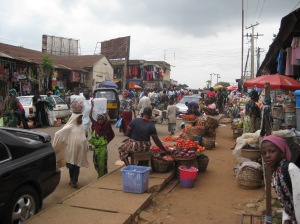
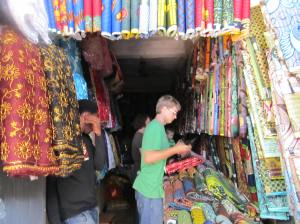
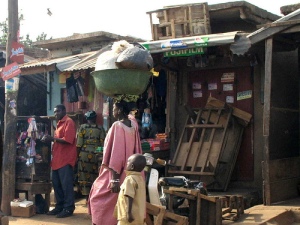
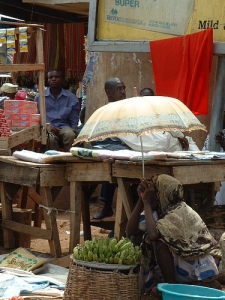
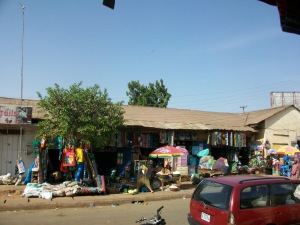
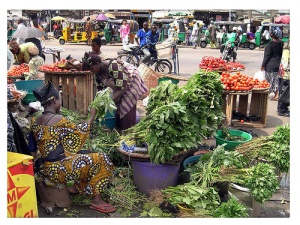
Pingback: Our Little MKs | Those Winklers
Thanks dear for the shout-out. I love reading your market adventures. Its always fascinating seeing how we experience market trips…Most of all, I love the way you now have the timing down to an art!
I like how your describe the market as a combination of all manners of events!
I like how you notice different things from what I’d notice, having lived in Nigeria for most of my years.
I have to visit Jos one of these days. Stay well
Well, I THINK I have the timing down, anyway – until dry season hits again! 😉 I always forget that it takes a bit longer in the heat.
I loved your pictures, though, in your market post. One day I’ll get that bold!
I loved reading this post. Lots of nostalgic feelings stirred up. I spent about 8yrs in Jos during schooling & internship. We had to relocate out of Jos due to the incessant crises. I haven’t been back in 3years now. Doubt if I’ll ever be, but I miss J-Town every single day!
Thanks for the fun memories this post brings.
Oh, that’s really cool! We are in the States right now to have a baby, and I have to say that I also miss Jos. After a few trips to the grocery store here and marveling at all the things one can get, I actually have found myself missing the market. Things take longer for us in Jos, but I also miss the simpler, less rushed lifestyle.
Thanks for commenting! 🙂